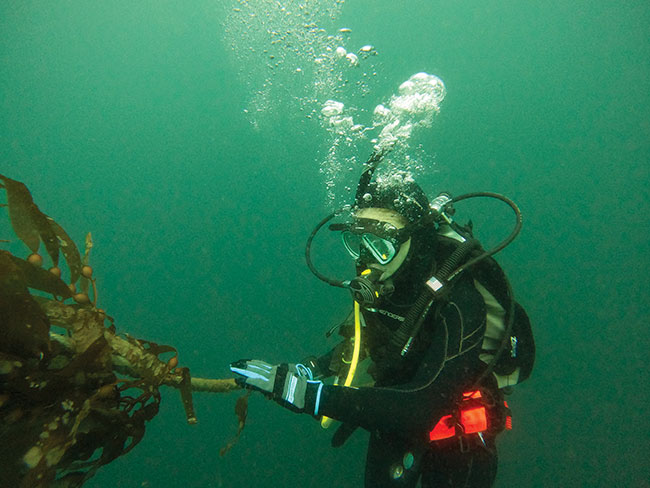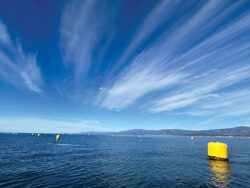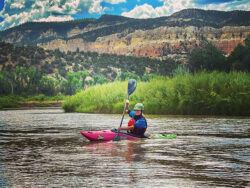
Eliza Harrison’s mission in Ocean Rainforest to address climate change with seaweed aquaculture
April 10, 2024
By
Seyitan Moritiwon
 Eliza Harrison diving in an Ocean RainForest offshore system in December 2023.
Eliza Harrison diving in an Ocean RainForest offshore system in December 2023. Every workday is different for Eliza Harrison.
But it’s typically split between being hands-on in the field and paperwork in the office all dedicated to the advancement of seaweed development.
On a Monday at work, Harrison, together with her small California team works to load a 25-foot boat, launch it off the ramp, and sail it out. The trio did a regulatory monitoring survey where Harrison flew a remotely operated vehicle to explore the ocean. Working together to manage a drone’s tether, Harrison and her colleagues take surveys. Later that day, she worked on a presentation for a stakeholder outreach project.
The idea behind the Ocean RainForest is to create a local ocean rainforest around the world to improve people’s well-being by growing seaweed while making a unique contribution to the earth, which aligns with Harrison’s interests.
Ocean RainForest, based in the Faroe Islands, is one of the largest seaweed cultivation and processing companies in the Western hemisphere. Harrison joined as the U.S. operations director in 2017. As the company has evolved, so has her title. She currently serves as the company’s director of California operations.
Birth of a new passion
When Harrison started noticing that the grasses and rivers she used to play in as a child in Santa Fe were drying up, “it reinforced this understanding that I really do want to be committed to or involved in mitigating the effects of climate change in some way, shape, or form.”

Eliza Harrison at the top of Mt. Langley in John Muir Wilderness. Mt. Whitney is shown in the background.
While she was studying environmental health science at the University of North Carolina, she was a part of the Robertson Scholars Leadership Program – a joint scholarship between Duke University and her school–and attended a conference where she learnt about the carbon sequestration potential that’s associated with seaweed farming.
Harrison came back from the conference and began working with different professors at the universities trying to understand if seaweed could be grown in North Carolina, and what species grow there. In 2017, she travelled to Scandinavia to learn more about seaweed aquaculture and landed an internship at Ocean Rainforest.
When an opportunity to get a permit for growing seaweed in California came up, she jumped at it. Harrison started as a business development coordinator, then became a program manager and now manages operations as director of California operations.
Seaweed aquaculture and climate change
Seaweed aquaculture is one the fastest-growing component of global food production and it offers a lot of opportunities to mitigate and adapt to climate change.

Ocean RainForest’s offshore cultivation facility in the Santa Barbara Channel.
“Seaweed is a really interesting kind of organism,” Harrison said, citing biomass potential, vitamins, minerals, and Omega fatty acids as some of the benefits of the algae.
“If you ferment it, it can improve, the gut health of animals. You can use it as a feed ingredient, you can extract different products from it, that can be used as gelling agents, you can run it through this biorefinery approach where you ultimately end up with biofuel, you can use it for feed for human food,” she said.
A 2023 report from the Swedish Environmental Protection Agency stated that when the red macroalgae seaweed, Asparagopsis, was added to cows’ diet, they produced less methane, which is the second-largest contributor to climate warming after carbon dioxide.
In 2018, Harrison’s passion led her to co-found Phyta, a seaweed cultivation initiative to provide a sustainable ingredient for consumer products and alleviate the effects of the climate crisis. Although the company was dissolved, Harrison’s passion still stands.
“Seaweed aquaculture is not a silver bullet. Seaweed is not going to save the world. But I think it is going to be a very important piece of how we adapt because it can provide this alternative input so that other resources can be redirected to where they’re potentially more valuable.” Harrison said.
Need for regulatory framework
Right now, Ocean Rainforest grows sugar kelp, (Laminaria saccharina), horsetail kelp (Laminaria digitata), and winged kelp (Alaria esculenta) and Harrison thinks there’s room for growth in the kelp aquaculture industry in North America. She said kelp aquaculture permitting is difficult in California and other parts of the United States because there’s no standardized protocol.

Eliza Harrison kayaking on the Chama River in Northern New Mexico.
“Within the regulatory agencies, there’s not yet a good understanding of what the risks and challenges and opportunities are that are associated with growing kelp in the ocean. And so that lack of familiarity, those lack of data, make it such that it’s hard for agencies to issue a permit,” she said. “Every permit that you try to get becomes this extensive conversation with the agencies about what the risks are.”
Harrison advocates for the implementation of a regulatory approach similar to Nationwide Permit 48. This particular permit, known as the Commercial Shellfish Mariculture Activities permit, is issued by the U.S. Army Corps once specific criteria for shellfish farming are satisfied.
She believes in designating a lead agency for coordinating the permit application process and having a regulatory framework for what documentation is required for a permit.
Harrison identifies other obstacles as market barriers and entry challenges. “As much as there’s a lot of enthusiasm, a lot of demand for seaweed, there’s not yet a framework for how you bring that product to market.”
What Harrison is helping to do at Ocean Rainforest is build some of those preliminary production lines to have a well-established Tech-to-Market pathway and move into a commercial permit application process.
“With those two things more well established, I think our company – but more broadly and more importantly, the industry as a whole – will have a baseline and a framework to build off of. And that’s really what’s going to kind of catapult kelp aquaculture into a state where it’s really making a difference in the context of climate change.”
Commitment to climate change
Harrison’s commitment to addressing climate change extends beyond her career. When she’s not working making things sustainable for the climate, she enjoys nature through telemark skiing, whitewater kayaking, and backpacking.

Eliza Harrison holding seaweed at an experimental farm in Northern Norway.
“I grew up just outside of Santa Fe, and Santa Fe is at the bottom of the Rocky Mountains. So it’s pretty high up in elevation, it’s 8,000 feet. It also affords access, very easily to skiing, mountain biking, kayaking, hiking… that connection to the outdoors is so incredibly important to me.”
She makes conscientious efforts to minimize energy consumption. She ensures that lights are only utilized when necessary and opts for walking and biking as her primary modes of transportation. “My poor housemates have gotten very used to me following them around and turning off lights if they just leave the lights on,” she said.
“I’m super interested in regenerative agriculture. I think it’s an absolutely fascinating space. And is a really interesting way of caring for the environment, but also producing protein,” she said, adding that she’d love to be more active in volunteering.
As a part-time member of the board of the California Aquaculture Association since 2022, she supports projects as they move through different permit or review processes.
“It’s a way for us to kind of collectively advocate as a state or as aquaculture across the state for different policies then translate toward or get moved toward the National Aquaculture Association.”
Advertisement
- Aquasend appoints new sales development representative
- First Nations coalition and B.C. farmers publish book on salmon farming





